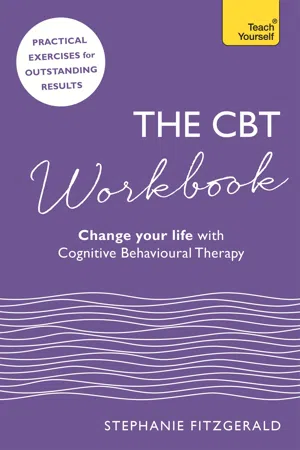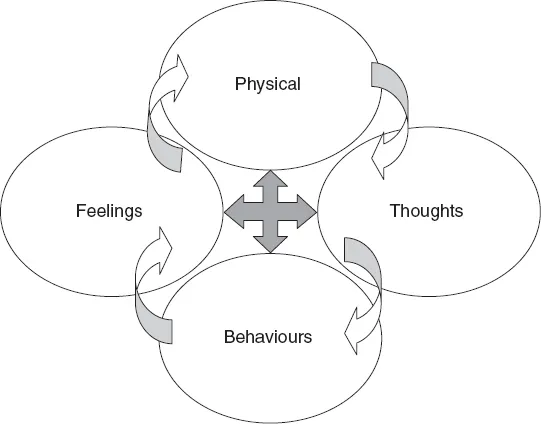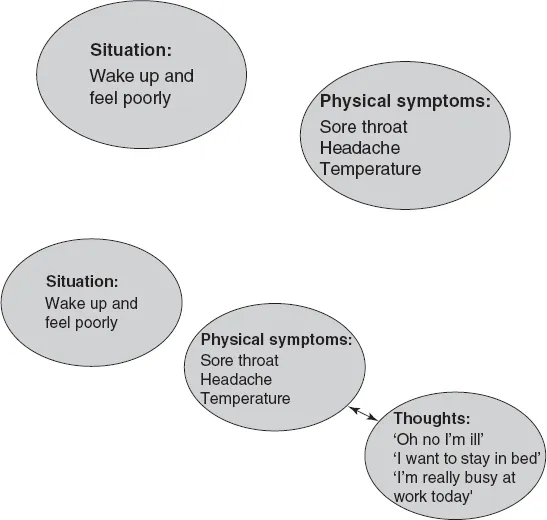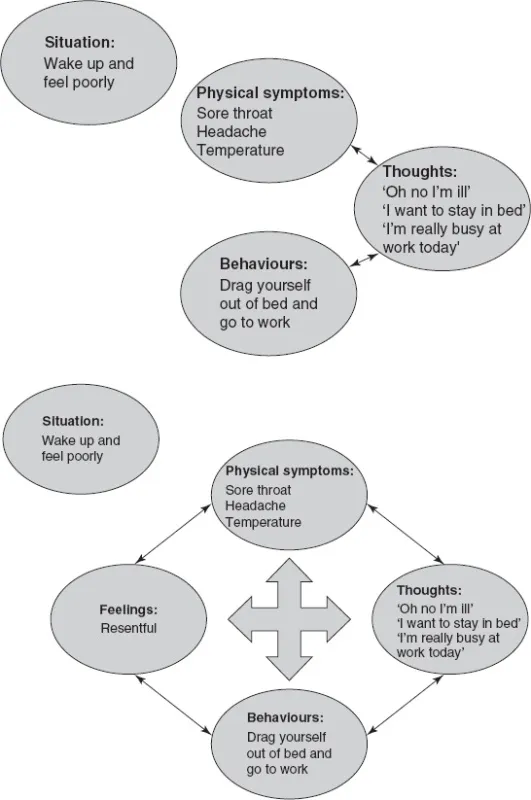![]()
1
How to use this book
What is this book about?
The CBT Workbook is designed to provide a practical introduction to the key principles and ideas behind Cognitive Behavioural Therapy (CBT). The style of the workbook means that you can read about, and then practise, some core techniques. Through completing short exercises and answering questions, you can begin to explore where CBT techniques will help you, and monitor the impact of the changes you make in your life.
What’s different about this book?
By incorporating the practical exercises, this workbook takes you beyond the theory and allows you to practise the techniques and see the results for yourself. If you are new to CBT, or are considering therapy and want to have a clearer idea of what that involves, then this book is perfect for you. Unlike other books on CBT, this book also considers those around you. Chapter 13 talks you through how to explain any changes you make to other people, as well as how to maintain these in situations others may make more difficult for you. Additionally, this book provides some help and support for those around you. The chapter for friends, family and carers is designed to help others make sense of what is going on for you and know how best to support and help you.
What can I expect?
This book focuses on the following areas:
• identifying your problem(s)
• setting goals to overcome these and achieve what you want
• identifying and challenging negative thinking
• behaving differently to change your feelings
• maintaining changes
• guidance for friends, family and carers to help support you
Each chapter starts with a discussion and follows with exercises for you to practise, which will move you from what you have just learnt and take you from the theoretical into reality. In other words, the exercises help you to lift the ideas from the page directly into your own life.
Can’t I just do the exercises?
No. In order for the exercises to be meaningful and effective, you will need to read through the introductory text at the beginning of each chapter. This will provide a context and rationale for why you are doing the exercises and how they will work. Doing the exercises in isolation is unlikely to be helpful as they will not make sense without the additional information provided.
I’ve never done CBT before – do I need anything before I get started?
In order for this book to be helpful, you need to allow yourself plenty of time to read through and try the individual exercises. Also you need to be patient. CBT is not a ‘quick fix’ nor is it a ‘magic cure’. It requires effort and input from you in order for progress to be made, but like most things in life, the more you put into it the more you will get out of it. If you allow yourself plenty of time and patience to complete this book you will see the benefits and be able to make positive changes.
What can I expect at the end?
After completing this book, you will be equipped with new ideas and strategies to help you overcome problems, and deal with negative and/or difficult situations that you are currently facing. However, the journey will not end there. The idea behind CBT is that it is not only effective whilst you are in therapy, but rather that you learn skills and techniques that you can use for life. This means that when you finish this book, you will only be at the beginning of your journey. You may notice significant changes throughout the book and you can continue to develop, change and achieve using the strategies this book teaches you for life. Enjoy the journey – the new you starts here!
![]()
2
Introduction to Cognitive Behavioural Therapy (CBT)
In this chapter you will:
• read a brief introduction into what Cognitive Behavioural Therapy (CBT) is.
• consider the types of disorders that CBT can help with.
• look at the focus and benefit of self-help CBT resources.
You will learn:
• more about the application of CBT to different problems and situations, and begin to consider how this applies to you.
What will I have to do?
• It is standard practice throughout CBT therapy for individuals to complete ‘homework’, e.g. work between sessions in order to build upon and develop the skills taught in each session. Throughout this workbook, there will be various activities and worksheets to complete to help you to begin to practise your CBT skills. However, this chapter serves as an introduction to CBT and as such there is no homework set at the end of this chapter.
So what is CBT?
There are a great many books and papers available which detail the development of CBT and its origins. The scope of this workbook doesn’t allow for an in-depth review of the history of its development, so here we will give a brief overview as to what CBT actually is.
When we break down the term cognitive behaviour therapy we can see the main components of the therapy:
The ‘cognitive’ part of CBT refers to our cognitions, or thoughts, and focuses on what we think in certain situations. CBT also focuses on our patterns of thinking and the way that our thoughts affect our mood and our behaviour.
The ‘behavioural’ part of CBT refers to our behaviours, or what we do, and again focuses on the way we behave in certain situations. CBT looks at the role that our behaviour plays in maintaining a particular problem or affecting our mood.
The ‘therapy’ part of CBT refers to changes that we make using a variety of techniques and strategies. The emphasis here is on the word ‘change’. CBT is a very practical and experiential therapy, whereby you try new ways of doing or thinking and monitor the impact of these changes. CBT is a hands-on therapy that looks at a situation from a variety of different perspectives and puts into practice new methods. Many people want to get some help with a situation but struggle to see how things can be different and so the idea of change may be hard to imagine. This book will explain how these changes can be made, using a variety of strategies, and will give you an opportunity to try out these techniques in a way that is comfortable and do-able for you.
Previous therapies, such as Cognitive Therapy (Beck, 1976) and Behavioural Therapy (Wolpe, 1958) have looked at thoughts or behaviours in isolation. However, CBT practitioners believe that many different aspects, including our thoughts and behaviours, interact with, and impact on, each other in different ways in different situations. The section below describing the basic underpinnings of CBT explores this idea further.
The basic underpinnings of CBT
CBT does not just focus on one area but instead it looks at the interactions between many different components. The premise of CBT is that our thoughts, feelings, behaviours and physical symptoms, together with the situation within which they occur, all affect and interact with each other. This is demonstrated in the five-areas diagram below which is often referred to as the ‘hot cross bun’ model (Padesky and Mooney, 1990) due to its appearance and the four different segments. The fifth area is the situation, and is defined by what or where it is that you want to change. For example, if you want to change how you think and behave in a meeting at work, then ‘in a meeting at work’ would be the situation that you would identify.
To give you an example of the way the different areas affect each other, a few examples have been drawn out below:
This example shows how physical symptoms can impact on our thoughts, feelings and behaviours. We can also see in the diagram below how thinking differently about something can change our behaviours and subsequently our feelings.
A basic principle of CBT is that because all these areas interact with each other, when we are able to change any one of these areas and we will see changes in all aspects of a situation.
This is helpful because people may find it much easier to access one area more than others. For example, we may be more aware of our physical symptoms than our thoughts, or more aware of how we feel rather than our behaviour in a particular situation. As one small shift can cause change in all these interlinked areas, then it is easy to see results and this helps us to build momentum to make other necessary changes.
If we believe in every situation that our thoughts, feelings, behaviours and physical symptoms all interact with each other and with the situation itself, then in order to see change we need to become aware of how we think, feel and act in a situation and then tackle one of these ...





